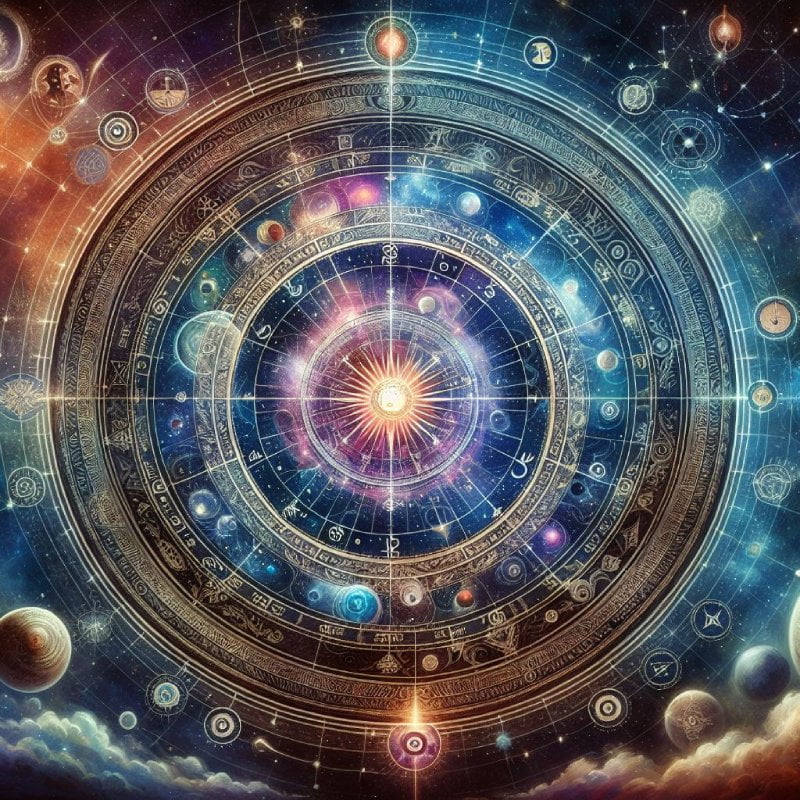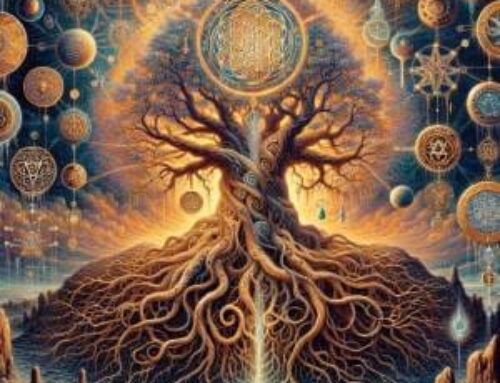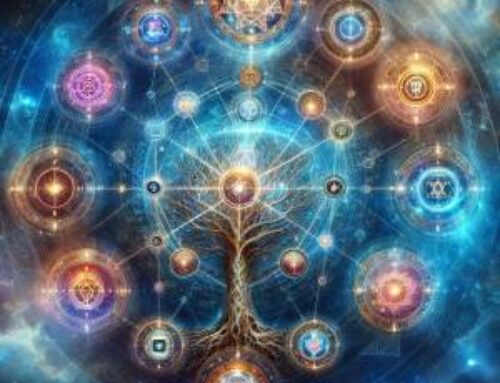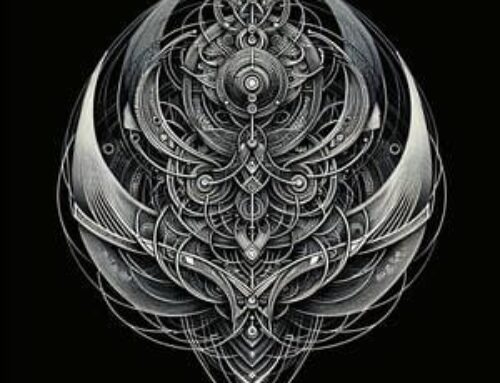Contents
Introduction to the Sepher Yetzirah Explained
Within the vast expanse of mystical literature, the Sepher Yetzirah, or the Book of Formation, arises as a pivotal text in the realm of Kabbalistic study. Ascribed to the venerable patriarch Abraham, this arcane manuscript explores the creation of the cosmos through thirty-two mystical avenues: ten Sephiroth and twenty-two letters of the Hebrew alphabet. This seminal document not only outlines the cosmic blueprint but also opens the portal to grasping the foundational structures of Kabbalistic philosophy. In the realm of Kabbalistic texts, ‘Sepher Yetzirah Explained’ offers a detailed exploration into the esoteric structure of the universe.
The primal tradition of the one and only revelation has been preserved under the name of Kabbalah by the priesthood of Israel (1).

The profound influence of the Sepher Yetzirah on mystical and philosophical traditions transcends its ancient origins. It provides a distinctive lens on the interplay between the divine and the material, portraying a sophisticated system of creation that resonates across spiritual practices and theoretical constructs. As we probe this text, we will unveil the layers of symbolism it contains, expose its philosophical breadth, and chart its enduring impact on mystical traditions.
In this discourse, we will traverse the historical narratives that sculpted the Sepher Yetzirah, explore its cosmological diagrams, and unravel the dense philosophical fabric that establishes the manuscript as a keystone of esoteric interpretation. Accompany us as we decipher the mystical dimensions of this age-old text, shedding light on the path toward an enriched metaphysical comprehension.
Kabbalistic doctrine, which is that of Transcendental Magic, is contained in the Sepher Yetzirah, the Zohar, and the Talmud (2).
Historical Context and Authorship
Origins and Composition
The Sepher Yetzirah, or the Book of Formation, is traditionally attributed to the patriarch Abraham and is a cornerstone of Kabbalistic mysticism. This text, believed to have been composed between the 3rd and 6th centuries CE, reflects a time of profound religious and philosophical ferment. It distills complex cosmological ideas using the ten Sephiroth and the twenty-two letters of the Hebrew alphabet, a method that frames the creation of the universe in a distinctly systematic way. This structure was notably influenced by Hellenistic philosophy, especially Neoplatonism, which envisioned the universe as emanating from a singular, divine origin.
Authorial Attribution and Mystical Authority
The foundational elements of this mystical manuscript are succinctly unraveled in ‘Sepher Yetzirah Explained,’ which delves into its complex symbolic network. No direct evidence links Abraham to the manuscript, yet this attribution enhances the text’s stature within Jewish mysticism, imbuing it with an ancient wisdom that resonates with both historical and spiritual significance. The association with Abraham also serves to embed the Sepher Yetzirah deeply within the spiritual lineage and identity of Jewish esoteric traditions.
Philosophical Influences
The Sepher Yetzirah’s composition during an era influenced by Neoplatonic thought highlights its philosophical depth. It mirrors the intellectual climate of its time, where Jewish and Hellenistic ideas intermingled, leading to a rich tapestry of theological and philosophical exploration. The text’s use of numerical and alphabetical systems to describe the cosmos indicates a sophisticated attempt to reconcile mysticism with the rationalist philosophies that were prevalent in the Mediterranean basin during the early centuries of the Common Era.
The Framework of Creation
The Mystical Map of the Universe
For those new to mystical studies, ‘Sepher Yetzirah Explained’ serves as an essential guide to understanding the intricate pathways of creation described in the text. At the heart of the Sepher Yetzirah lies its most profound and structurally significant concept: the framework of the ten Sephiroth and the twenty-two paths formed by the Hebrew letters. This schematic not only outlines the metaphysical structure of the universe but also acts as a symbolic blueprint for the mystical processes of creation. The ten Sephiroth represent the emanations of God’s will, illustrating various attributes through which the ineffable nature of the divine becomes manifest in the material world. Through ‘Sepher Yetzirah Explained,’ readers gain insights into the dynamic balance of cosmic forces that the manuscript portrays.
The Sephiroth: Ten emanations represent the process of creation and the nature of the divine, forming a tree of life structure (3).
Interplay of Numbers and Letters
The Sepher Yetzirah organizes the cosmos through a unique combination of numerical and alphabetical symbolism, reflecting a cosmic order that is governed by divine logic and abstract mathematical principles. Each Sephirah is interconnected through twenty-two paths, each path corresponding to a letter of the Hebrew alphabet. This intricate connectivity suggests a universe that is not randomly formed but is instead a product of divine calculation, where each letter and number holds specific esoteric significance.
Cosmological Dualities and Their Harmonization
The text explores the dualities inherent in the cosmos, such as light and darkness, fire and water, expanding and contracting forces, which it refers to as the opposing yet complementary attributes of God’s creation. These dualities are not seen as conflicts but as harmonizing elements that sustain the universe in a dynamic equilibrium. By understanding these fundamental forces, Kabbalists believe they can mimic the creative acts of God through meditative and ritualistic practices, essentially engaging with the divine process itself.
Human Soul and the Divine: The human soul is seen as a microcosm of the divine structure, with parts corresponding to the Sephiroth (4).
Practical Implications and Meditative Practices
Beyond theoretical cosmology, the Sepher Yetzirah’s framework serves as a guide for mystical practice. The combination of letters and numbers provides a meditative tool for practitioners to align their spiritual practice with the archetypal forces represented by the Sephiroth and paths. This alignment is believed to facilitate personal and cosmic harmony, enabling the practitioner to attain deeper insights into the nature of reality and their place within it.
A Template for Creation
Fundamentally, the Sepher Yetzirah presents a template through which all of creation, both heavenly and earthly, can be understood and influenced. It posits that by engaging with this template, one can replicate the creative vibrations that constituted the universe. Thus, the text is not merely a theoretical treatise but a functional guide to spiritual empowerment and enlightenment.
Mystical Insights and Philosophical Themes
Unveiling the Mystical Insights
The article on ‘Sepher Yetzirah Explained’ meticulously outlines the connection between the divine and the material realms through the Sephiroth and the Hebrew alphabet. The Sepher Yetzirah is not only a cosmological blueprint but also a profound source of mystical insight, particularly through its discussion of the Tzimtzum, the act of divine contraction. This Kabbalistic concept describes how the Infinite Source (Ein Sof) initiated creation by contracting itself to create a conceptual space for the universe. This notion of divine self-limitation is critical for understanding the dynamic between the limitless nature of the divine and the finite reality of the created world.
Philosophical Depth of Creation
This text dives deep into the philosophical underpinnings of existence, suggesting that reality is a structured reflection of divine thought. Each of the ten Sephiroth and twenty-two paths serves not only as a metaphysical entity but also as a channel through which the divine essence is continuously manifested in the physical realm. The philosophical implication is profound: the material universe is essentially a construct of divine language, written in the alphabet of the Sephiroth and paths.
The Sefirotic Harmony and Ethical Living
As we dissect ‘Sepher Yetzirah Explained,’ we uncover the philosophical themes that underpin the text’s depiction of the universe. The interconnections between the Sephiroth depict more than cosmic forces; they illustrate moral and ethical pathways that guide the adherent towards spiritual harmony. For instance, the balance between Chesed (mercy) and Gevurah (severity) teaches the necessity of tempering justice with kindness. This balance is crucial for personal development and is a recurring theme in Kabbalistic ethical teachings (5).
The Pathways of Ascension
The twenty-two paths, each linked to a Hebrew letter, represent both literal and allegorical journeys within the seeker’s spiritual quest. They are not only routes between the divine emanations but also symbolic of challenges and transitions that the soul must navigate in pursuit of enlightenment. Engaging with these paths through meditation and ritual allows the practitioner to traverse these spiritual landscapes and align more closely with divine attributes.
Integration with Universal Law
The philosophical discourse in the Sepher Yetzirah extends to universal laws governing all creation. It posits that understanding these laws is key to mastering the art of creation, mirroring the divine acts that structured the universe. This mastery is not aimed at dominion but at achieving a profound communion with the cosmic order, which in turn elevates the human spirit to its highest potential.
Conclusion
The Sepher Yetzirah, or the Book of Formation, serves not merely as an ancient text but as a profound guide to understanding the universe’s mystical and philosophical underpinnings. From its complex mapping of the cosmos through the Sephiroth and the paths of the Hebrew alphabet to its deep dives into the nature of creation via divine contraction (Tzimtzum), the Sepher Yetzirah offers a unique lens through which we can view the interplay between the divine and the material. It challenges us to perceive the world as a manifestation of divine language, structured through esoteric laws that guide both the cosmos and the paths of spiritual seekers. Each section of ‘Sepher Yetzirah Explained’ is crafted to illuminate the mystical and practical applications of the teachings found within the Book of Formation.
By engaging with the teachings of the Sepher Yetzirah, we align ourselves not only with the metaphysical realities of the universe but also with a disciplined path towards personal spiritual enlightenment. This text encourages an ethical, balanced approach to life, promoting a harmonious existence that reflects the divine structure of the universe itself. The detailed commentary in ‘Sepher Yetzirah Explained’ enhances our comprehension of this ancient text, making its profound teachings accessible to modern seekers.
Seek the Light
Explore the teachings of the Hermetic Academy to probe further into the wisdom of the Sepher Yetzirah and other arcane texts. Join a community that cherishes deep knowledge and the practical applications of these age-old insights in contemporary existence. Whether you are an experienced practitioner or a curious novice, the Hermetic Academy provides courses, resources, and a dynamic community to bolster your spiritual quest. Seize this chance to revolutionize your understanding of the cosmos and your role within it.
FAQ – Sepher Yetzirah Explained
1. What is the „Sepher Yetzirah Explained”?
A: The Sepher Yetzirah, or the Book of Formation, is esteemed as one of the profound manuscripts of Jewish mysticism. It reveals a singular system of Kabbalistic cosmology, pivotal to the esoteric scholarly canon. This ancient treatise deciphers the cosmic creation through the interwoven dynamics of ten divine emanations, known as Sephiroth, and twenty-two mystical pathways corresponding to the Hebrew alphabet, each a conduit of celestial wisdom.
A: Enshrouded in the veils of time, the authorship of the Sepher Yetzirah is attributed by lore to Abraham, the venerable patriarch whose insights are foundational to the mystical traditions of the scriptures. This ascription imbues the text with a sacred aura of profound antiquity and wisdom.
3. How does the Sepher Yetzirah explain the creation of the universe?
A: The Sepher Yetzirah unfolds the genesis of the universe through the mystical concept of Tzimtzum, or divine contraction, proposing that the boundless essence of God withdrew, thereby making space for the finite universe to manifest. This act of cosmic alchemy is depicted as a divine choreography of contraction and expansion, reflecting the eternal interplay between the infinite and the manifest world.
4. What are the main philosophical themes in the Sepher Yetzirah?
A: At the heart of the Sepher Yetzirah lie profound philosophical themes: the continuum between the infinite and the finite realms, the oscillation of cosmic dualities, and the pursuit of spiritual enlightenment through a deep, intuitive understanding of the divine structure of the universe. The text advocates for a contemplative engagement with life, aiming to align one’s soul with the celestial order through meditative insight and moral integrity.
5. Where can I learn more about the teachings of the Sepher Yetzirah?
A: The Hermetic Academy stands as a beacon for those drawn to the arcane depths of the Sepher Yetzirah and similar texts. Here, one may find a structured pathway of study, guided by sage wisdom and supported by a fellowship of like-minded seekers. The Academy offers a sanctuary for profound exploration and practical application of these ancient mystical doctrines, facilitating a journey of personal and spiritual transformation.
References:
(1) Eliphas, L. (1854). Dogme et Rituel de la Haute Magie. Paris.
(2) Eliphas, L. (1854). Dogme et Rituel de la Haute Magie. Paris.
(3) Mathers, S. L. M. (1887). The Kabbalah Unveiled. London.
(4) Mathers, S. L. M. (1887). The Kabbalah Unveiled. London.
(5) Rubenstein, E. (2020). The Tree of Life: The Kabbalah of Immortality. Hermetic World, Paphos.





